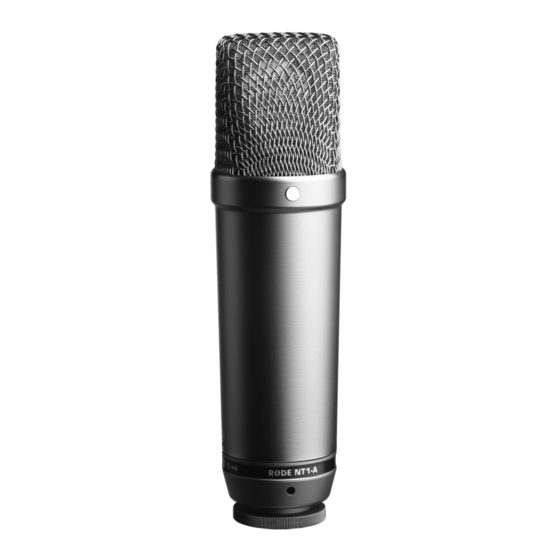
RODE Microphones NT1-A Instruction Manual
Studio condenser microphones
Hide thumbs
Also See for NT1-A:
- User manual ,
- Instruction manual (33 pages) ,
- Quick start manual (9 pages)
Table of Contents
Advertisement
Quick Links
Advertisement
Table of Contents

Summary of Contents for RODE Microphones NT1-A
- Page 1 NT1-A Instruction Guide STUDIO CONDENSER MICROPHONES...
- Page 2 Please take the time to read the following information which will help you to achieve the best possible performance from your NT1-A.
-
Page 3: Technical Specification
• Dynamic Range: > 132 dB (per IEC651, IEC268-15) • Maximum SPL: 137 dB (@ 1% THD into 1kΩ) • Signal/Noise: > 88 dB (1kHz rel 1 Pa; per IEC651, IEC268-15) • Power Requirements: Phantom P48, P24 NT1-A Polar Response NT1-A Frequency Response... - Page 4 • Monocoque sub-assembly. • Internal shock-mounting system. • Gold plated output connectors. • True Condenser (externally biased). • Full (20Hz – 20 kHz) frequency response. NT1-A Base Pin 3 (-) Pin 2 (+) Pin 1 (Ground) Cable plug guide Note: Ensure cable is connected to correct pins.
- Page 5 NT1-A in SM1 Shock Mount 3/8” - 5/8” Thread Adaptor...
-
Page 6: The Power Supply
5. We strongly suggest the use of a reputable high quality power supply. Damage to the NT1-A caused by a faulty power supply is not covered by the warranty. Microphone Placement: Microphone technique, or how to get the sound you want, requires experimentation. - Page 7 Changing the acoustic properties of the space the microphone is in, is our recommended initial approach for obtaining the best sound quality. (Remember, you cannot change a rooms acoustic properties with EQ). When the preferred sound has been achieved (as above) then, EQ and effects such as reverb or indeed any other signal processing can be used for enhancement, but should be used sparingly.
-
Page 8: Electric Guitar/Bass
Perhaps a good beginning would be to place the pop filter directly in front of the vocalist, and about 15cm away from the microphone. (Remember that the front of the microphone is indicated by the gold dot). This will assist in keeping the performer at a constant minimum distance from the microphone and helps to maintain reasonable recording levels. - Page 9 An effective stereo image can be achieved, with lower frequencies being recorded on the left, and the higher frequencies on the right. Drums: NT1-A facing down towards drum kit There are various ways to record drum kits. Single microphone ‘overhead’, two microphones...
-
Page 10: Acoustic Guitar
NT 3 3/4” capsule, RODE NT 5 1/2” capsule) closer to the guitar, AND a large capsule microphone such as the NT1-A further away from the instrument (perhaps 1m +/-). The sounds recorded by each microphone can then be mixed as preferred. -
Page 11: Warranty
Instruction Guide. There are no user-serviceable parts inside the NT1-A and so there will never be a reason for you to dismantle it. In fact, to do so may nullify any warranty claim. - Page 12 International RODE Microphones, 5 Averill St, Rhodes NSW 2138 Australia 61 2 8765 9333 Fax: 61 2 8765 9444 P.O. Box 3279 Torrance, CA 90510-3279 877 328 7456 (Toll Free Within the U.S.) 310 328 7456 Fax: 310 328 7180 Technical Support For information and technical support questions.















Need help?
Do you have a question about the NT1-A and is the answer not in the manual?
Questions and answers